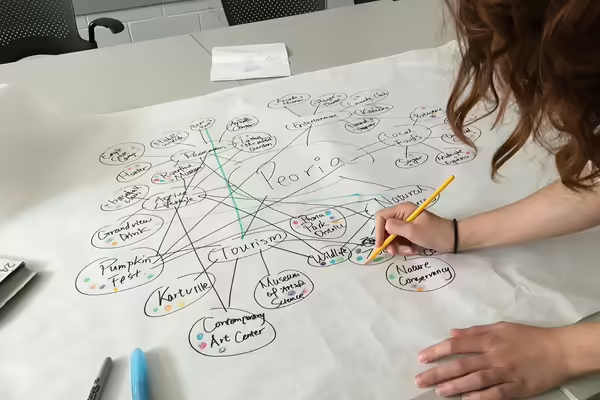
PEORIA, Ill. –The city of Peoria will break ground on a pilot project transforming vacant land on the city’s south side into a “stormwater farm” that will help manage chronic sewer overflows impacting low-income neighborhoods while simultaneously significantly enhancing community health and vibrancy.
The effort is the culmination of more than a year of engagement and dialogue-building across a broad and diverse set of stakeholders that was supported by a group of students and faculty from the University of Illinois School of Architecture and University of Illinois Extension, working with the city of Peoria’s Innovation Team.
Extension educator Kathie Brown, based in Peoria, facilitated meetings between students and community members.
“The students gain so much from these interactions. They talk to people from all walks of life – neighborhood residents, local engineers, and architects – people they don’t usually hear from as a part of their classwork,” said Brown. “I think that’s the piece where Extension can enrich the campus experience in so many ways, because of this collaborative engagement with the community.”
Students from several areas of study worked closely with the city to help with groups of community members and diverse stakeholders to think through solutions to Peoria’s stormwater infrastructure issues starting with, “How do we use design solutions to improve public health?”
Students used what they heard to design concepts for different ways to address the challenges, which went through further community input and refinement. The outcome was a set of solutions that were derived from the community and built around consensus on priorities — in the case of the south side stormwater farm, this meant creating a project that went beyond solving sewer overflows to include features such as urban agriculture and job training programs.
Brown says this collaboration is a boon to Peoria. “I always feel excited about the opportunity to engage with [University of Illinois] campus members because of the new ideas they bring to community groups, and the expertise they can offer to help communities grapple with these tough issues.”
The Peoria project is an example of a growing national movement to connect design solutions to public health outcomes. The U of I is a member of the Design and Health Research Consortium, a collaboration of the American Institute of Architects (AIA) and the Association of Collegiate Schools of Architecture (ACSA) to advance university-led research in the area of design and health.
The collaboration between University of Illinois Extension and the College of Fine and Applied Arts is part of the Designing Healthy Communities Initiative, funded through the University of Illinois Extension and Outreach Initiative, with support from the University of Illinois Office of the Provost and the College of Agricultural, Consumer and Environmental Sciences.
Photo courtesy of College of Applied and Fine Arts: Urban Planning Masters students Emily Weimer and Rachael Wilson went beyond the classroom, choosing to focus their final projects, known as Capstones, on specific health challenges in two Peoria neighborhoods.
Illinois Extension leads public outreach for University of Illinois by translating research into action plans that allow Illinois families, businesses, and community leaders to solve problems, make informed decisions, and adapt to changes and opportunities.